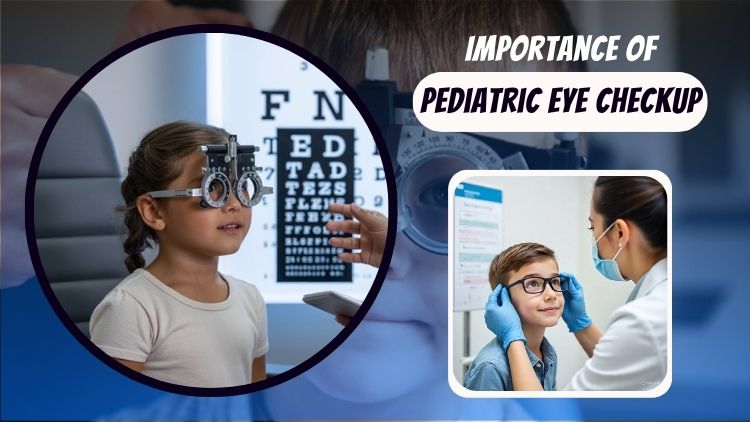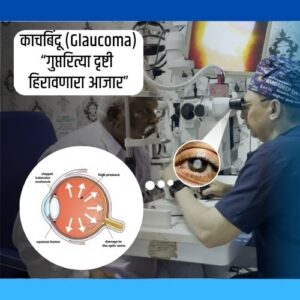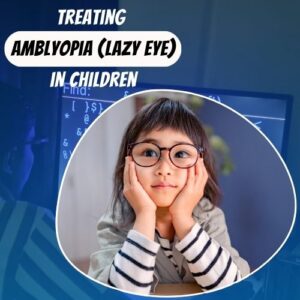Everything You Should Know About Pediatric Eye Check-Ups

Introduction
Did you know that your child’s eyesight plays a vital role in their learning and development? Good vision helps children explore their surroundings, perform better in school, and grow with confidence. However, one in four school-aged children may have an undiagnosed vision problem, according to research.
At Nandadeep Eye Hospital, we believe early detection and regular pediatric eye check-ups are essential to ensure your child enjoys a bright, healthy future.
When Should Pediatric Eye Exams Begin?
Many parents ask, “When should I take my child for their first eye exam?” The answer is: earlier than most people think!
- At birth, Most hospitals or paediatricians do a quick eye check to rule out any serious issues.
- Around 6 months: A more detailed exam can spot early signs of problems with eye movement or focus.
- By age 3: This is when the eyes are still developing, so it’s a good time to check for things like lazy eye or eye misalignment.
- Before starting school (around age 5–6): Kids rely heavily on vision for reading and classroom activities. It’s crucial to make sure their vision is sharp before school begins.
- Once a year after that (or as advised): Regular check-ups help track vision changes and catch any new issues early, especially as screen time and study hours increase.
Common Vision Problems in Children
There are several types of eye conditions that can affect children. Some are easy to miss if you’re not looking for them.
- Myopia (nearsightedness): Your child can see things up close but struggles to see objects far away, like the whiteboard in class.
- Hyperopia (farsightedness): It’s the opposite—they may have trouble seeing up close but can see well at a distance.
- Astigmatism: This causes blurry or distorted vision at all distances due to an irregularly shaped cornea.
- Strabismus: When the eyes don’t move together properly, one eye may turn inward or outward.
- Amblyopia (lazy eye): One eye becomes weaker because the brain favours the other. It’s one of the most common causes of vision problems in kids.
- Colour blindness: Often inherited, this affects a child’s ability to tell certain colours apart, especially red and green.
- Binocular vision dysfunction: This means the eyes don’t work together as a team, making reading and focusing difficult.
Book a kids’ eye check-up at Nandadeep Eye Hospital to ensure your child is on the right developmental track.
Signs Your Child May Need an Eye Exam
Children may think that everyone sees the world in the same way they do, and they are not always able to express their vision issues. The following are indicators to look out for:
- Regular blinking or rubbing of the eyes
- Tilting the head or squinting to see clearly
- Keeping screens, toys, or books near the face
- Having trouble focusing when reading or doing assignments
- Reports of eye strain, headaches, or fatigued eyes
- Reading challenges or low academic performance
- Red eyes, light sensitivity, or increased tear production
If you notice any of these, it’s a good idea to book a full eye check-up.
What Happens During a Pediatric Eye Check-Up?
A pediatric eye exam is nothing to worry about—and it’s usually quick and painless. Here’s what you can expect:
- Medical history review: The doctor will ask about your child’s health, birth history, and any family history of eye problems.
- Vision testing: Your child will read from an eye chart (or use picture charts if they’re not reading yet) to measure how well they can see.
- Eye alignment and movement check: This helps detect crossed eyes, lazy eye, or muscle coordination issues.
- Refraction test: This shows whether your child needs glasses and, if so, what prescription is required. The doctor may use dilating drops to get an accurate result.
- Eye health exam: The doctor looks at the front and back parts of the eyes using special lights and lenses to check for diseases or abnormalities.
- Developmental screening: Especially in younger kids, this assesses how well their vision supports tasks like eye-hand coordination and focus.
Vision Screening vs. Comprehensive Eye Exam
Basic vision exams are available at many paediatric clinics and schools, but it’s crucial to understand that they cannot replace an in-depth eye test.
A vision screening is an evaluation to see whether your child can read letters on a chart. It is often performed by a paediatrician or school nurse. Although it can identify obvious abnormalities, it could miss more subtle ones like lazy eye, poor eye coordination, or trouble seeing depth.
On the other hand, a comprehensive eye exam is performed by a children’s eye specialist (optometrist or ophthalmologist) and gives a complete picture of your child’s vision and eye health. It checks how well the eyes work together, whether glasses are needed, and whether there are any underlying conditions that could affect development.
In short: if your child passes a vision screening, that’s great—but it doesn’t guarantee everything is perfect. Full eye exams are the only way to be sure.
Why Regular Eye Check-Ups Matter
There are lots of benefits to getting your child’s eyes checked regularly:
- Prevent vision loss: Many eye problems can be reversed or managed if caught early.
- Boost learning and school performance: Vision problems are one of the most overlooked causes of academic struggles.
- Track development: Eyes grow and change just like the rest of the body, so regular exams ensure things are on track.
- Promote safety and confidence: A Clear vision helps kids feel more confident in sports, social settings, and daily tasks.
How to Prepare Your Child for the Eye Exam
Eye exams can feel a little intimidating to kids, especially if it’s their first one. Here’s how you can make it easier:
- Discuss the exam in a positive and relaxed manner.
- Let them know what to expect—maybe even show them a short video or book about eye doctors.
- Choose a time of day when your child is well-rested and not hungry or cranky.
- Bring their medical records or previous prescriptions if they’ve had eye exams before.
- Encourage them to ask questions during the exam—this helps build trust with the doctor.
Treatment Options for Pediatric Vision Problems
If your child is diagnosed with a vision issue, there are many ways to treat it, depending on what’s needed:
- Glasses: The most common and straightforward solution for refractive errors like myopia or astigmatism.
- Vision therapy: A series of guided eye exercises to improve coordination and focusing ability.
- Patching: For treating lazy eye, the stronger eye is covered for a few hours daily so the weaker eye can catch up.
- Eye drops: Special drops, like atropine, are sometimes used to slow the progression of myopia in kids.
- Surgery: In some cases—especially for strabismus (crossed eyes)—a surgical procedure may be recommended to align the eyes properly.
Myopia in Children: A Growing Concern
In the modern world, myopia, or nearsightedness, is becoming more common in children and occurring at younger ages. Reduced outdoor activity and more screen time are considered to be the primary causes by experts. Myopia can develop more quickly the sooner it is initiated.
Fortunately, there are techniques to control it. Some children benefit from atropine drops, speciality lenses, or even ortho-k lenses that are used overnight to gradually straighten the eye in addition to spectacles. It has also been found that spending more time outside lowers the risk.
Ask your eye doctor about all of the options available if you feel your child has myopia.
Tips for Keeping Kids’ Eyes Healthy
You can do a lot at home to support your child’s visual development:
- Limit screen time: Follow age-appropriate guidelines and encourage screen breaks every 20 minutes.
- Encourage outdoor play: Sunlight and natural distance focusing help reduce the risk of myopia.
- Feed their eyes: Include vision-friendly foods like leafy greens, carrots, eggs, fish, nuts, and fruits in their diet.
- Use protective eyewear: Especially for sports or risky activities like cycling or swimming.
- Practice good hygiene: Teach kids to avoid rubbing their eyes and to wash their hands frequently—this helps prevent infections.
Conclusion
How your child learns, moves, and perceives the environment is influenced by their eyesight. Paediatric eye exams are, therefore, equally as crucial as routine dental or physician checks.
Book an appointment for your child’s eye exam today at Nandadeep Eye Hospital—trusted by thousands of families for expert, compassionate, and advanced pediatric eye care in India.









